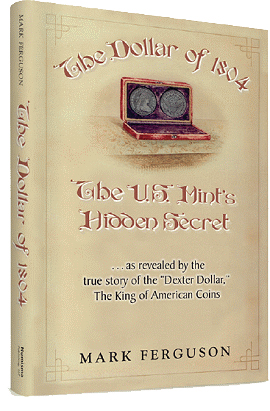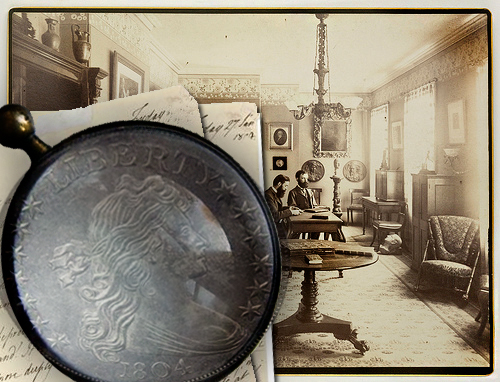First Read, a CoinWeek continuing series of essays about classic and contemporary works of numismatic literature
By Charles Morgan and Hubert Walker for CoinWeek….
The Dollar of 1804: The U.S. Mint’s Hidden Secret (…as revealed by the true story of the “Dexter Dollar,” The King of American Coins), by Mark Ferguson.
The Long Shadow
It’s hard reading Mark Ferguson’s book without thinking of Eric P. Newman and Kenneth Bressett’s The Fantastic 1804 Dollar (1962). Not only does every book concerning 1804 dollars have to answer, in some way, to that landmark work, but The Dollar of 1804: The U.S. Mint’s Hidden Secret feels like Ferguson’s direct response to it.
 Where Fantastic succeeded was in its full-throated challenge to what was then orthodoxy regarding the coin’s origins. Before its publication, the 1804 dollar was a coin steeped in mystery and mythology, made ever murkier by dubious claims, accusations, and self-serving marketing. Newman and Bressett sought to cut through the hype surrounding the “King of American Coins” and assert, once and for all, that the coin was an imposter, by all evidence struck much later than its inscribed date. Every 1804 dollar, according to Newman and Bressett, was in fact, a coin of dubious origins.
Where Fantastic succeeded was in its full-throated challenge to what was then orthodoxy regarding the coin’s origins. Before its publication, the 1804 dollar was a coin steeped in mystery and mythology, made ever murkier by dubious claims, accusations, and self-serving marketing. Newman and Bressett sought to cut through the hype surrounding the “King of American Coins” and assert, once and for all, that the coin was an imposter, by all evidence struck much later than its inscribed date. Every 1804 dollar, according to Newman and Bressett, was in fact, a coin of dubious origins.
But as Ferguson points out, in some respects Newman and Bressett got lucky. The timing of the release of their book allowed them to clean up some glaring mistakes and caused them to tone down some dubious claims and accusations of their own making.
Judging by the new facts revealed in The Dollar of 1804, we still have a lot to learn about this most fantastic of American numismatic mysteries.
The Dexter Dollar
Every 1804 dollar has a fascinating backstory. Of all of them, the Dexter dollar may be the most misunderstood.
Ever since the coin’s first known public offering in a German auction conducted by Adolph Weyl, the Dexter dollar has been the subject of scrutiny, suspicion, and slander.
Even Newman and Bressett got their digs in, alleging that its placement in the Weyl catalog was a conspiracy on the part of the Chapman Brothers to conceal its true origin by giving it a phony European pedigree.
Coin dealer and Chapman rival Edouard Frossard advanced a similar theory. He filled the pages of his publication Numisma with biting assertions that the coin was a restrike and that the Chapmans were perpetrating a fraud. Frossard looms large in the narrative and his mission to discredit the Chapmans plays a major role in the Dexter story.
Ferguson’s book makes pains to enlighten us with actual facts. For too long, the Dexter dollar has been shrouded in intrigue. How Weyl acquired the 1804 dollar remains unknown, Ferguson writes, but surviving correspondence between the Chapmans and Weyl unravel any alleged conspiracy that the two parties were working together to conceal the coin’s original source.
Ferguson is clearly at home with the material. His knowledge of the Dexter dollar is encyclopedic and he goes into great detail documenting the coin and its various owners, starting with James Vila Dexter. This information is interesting and vital to our understanding of the burgeoning coin industry of the 19th century.
From Weyl to the Chapmans, then to Low, Mehl, Stack’s, RarCoa, Superior, and Stack’s again–the list of those who’ve handled and transacted the coin reads like a numismatic variant of the Six Degrees of Kevin Bacon game, reminding us that for some of these truly rare delicacies, we’re not far removed from 19th century provenance and the birth of the American hobby.
 James Vila Dexter also looms large in the narrative, as Ferguson corrects, for the record, Dexter’s place as one of the 19th century’s significant collectors. Not only did Dexter pay a record sum of $1,000 for the coin, Ferguson writes, he also kept detailed records of his holdings, which included numerous rare and valuable gold and silver coins of the early federal period. The 1804 dollar, it turns out, may have been his rara avis, but it was not alone in a collection that today would sell for several million dollars and warrant its own auction catalog.
James Vila Dexter also looms large in the narrative, as Ferguson corrects, for the record, Dexter’s place as one of the 19th century’s significant collectors. Not only did Dexter pay a record sum of $1,000 for the coin, Ferguson writes, he also kept detailed records of his holdings, which included numerous rare and valuable gold and silver coins of the early federal period. The 1804 dollar, it turns out, may have been his rara avis, but it was not alone in a collection that today would sell for several million dollars and warrant its own auction catalog.
A Fish Tale
Most of what Ferguson presents can be taken at face value and filed away in our collective collector brains. It’s reliable and verifiable information presented in an easily digestible and interesting narrative style.
One topic, however, warrants serious caution. And it’s something that has bothered us since we first read the book and continues to nag at us today.
This topic is a theory, centrally important to Ferguson’s narrative but only briefly touched upon, having to do with a possible explanation of the disappearance of the 1804-dated dollars struck in 1804.
While there’s no smoking gun that proves or disproves the existence of said coins, no 1804 dollar business strikes have ever surfaced. This led Newman and Bressett to believe that if any silver dollars were actually struck in 1804, they would have carried the date “1803”.
In the 19th century, however, less formal research was conducted into the topic, and various books and newspapers columns throughout the years spun a yarn about the disappearance of the coin. These accounts were usually published in close proximity with the highly publicized public offering of an 1804 dollar proof, such as the one Dexter purchased in 1885 for a record price.
As the story goes, the United States government, at war with the Barbary pirates since the beginning of the Jefferson Administration, paid a sum of $60,000 in tribute (or ransom) to free captured Americans held as prisoners in Tripoli. The mission took place in early 1805, but there’s no evidence as to what form of money the mission carried for the purpose. Maybe they were 1804 dollars, or 1803 dollars struck in 1804, or maybe they were neither of these coins. It could have been worn Mexican coins for all we know.
What is clear is that Dexter believed this story. He had a piece of art commissioned that told of the expedition in great detail. A book written in 1883 by Ivan C. Michels, Ph.D., may have been the source, Ferguson points out.
Still, there’s little evidence presented to support the theory, but not for a lack of trying, Ferguson explained to us.
Then why include it? Without solid evidence to support it, the tightly knit yarn about Dexter and the 1804 dollar reveals a loose string.
“Joel Orosz, who wrote the forward, told me I had to tamp it down,” Ferguson told us, “otherwise he wouldn’t have written the forward. But the facts are there, the mission did take place and significant payments were made. How they were made, I don’t know.”
Ferguson hopes that by including the story it will stir the interest of someone with more access to historical records than he was able to unearth. He also feels that prior researchers refused to accept the possibility that 1804 dollars might have been struck in 1804.
If this theory turns out to be right, it would be big news. But the story of those coins, if they existed, is not the story of the Dexter dollar and its 14 known siblings. Those coins belong to a different age.
The Dollar of 1804: The U.S. Mint’s Hidden Secret (…as revealed by the true story of the “Dexter Dollar,” The King of American Coins)
by Mark Ferguson
286 Pages. Self Published (Numisma Publishing, LLC). $29.95.
You can order the book at www.1804Dollar.com.
***
 Charles Morgan is a member of the American Numismatic Association, the American Numismatic Society, the Numismatic Literary Guild, Central States Numismatic Society, and the Richmond Coin Club. Hubert Walker is a member of the American Numismatic Association and the Numismatic Literary Guild. Together, they have written numerous articles for publication online and in print, including two 2013 NLG award-winning articles for CoinWeek.com.
Charles Morgan is a member of the American Numismatic Association, the American Numismatic Society, the Numismatic Literary Guild, Central States Numismatic Society, and the Richmond Coin Club. Hubert Walker is a member of the American Numismatic Association and the Numismatic Literary Guild. Together, they have written numerous articles for publication online and in print, including two 2013 NLG award-winning articles for CoinWeek.com.
Want to know what we’re up to? Follow Charles on Twitter.
© May 2014 COINWeek.com, LLC.





Very interesting take on the book. I’ll check it out.